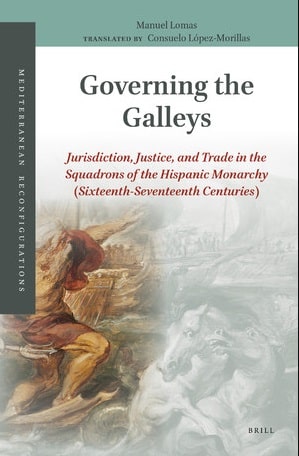
| Book Title | Governing The Galleys |
| Book Author | Manuel Lomas |
| Total Pages | 202 |
| Book Views | |
| Language | English |
| Book Download | PDF Direct Download Link |
| Get Hardcover | Click for Hard Similar Copy from Amazon |
Governing the Galleys: Jurisdiction, Justice, and Trade in the Squadrons of the Hispanic Monarchy (Sixteenth–Seventeenth Centuries) By Manuel Lomas Translated by Consuelo López- Morillas
GOVERNING THE GALLEYS
Introduction
The study of galleys is no longer confined to the history of events, navigation, or tactics. The classic paradigm has gradually been transformed: essentially descriptive— of types of ships and their components, or of the number and composition of their crews— it also served nationalist ends.
The affirmation of an epic, glorious past could legitimate a nation’s identity and its role in building the political, legal, and cultural reality of the modern-day Mediterranean.
This change in emphasis has come about slowly and has involved different analytical approaches. One of the earliest innovations highlighted the technical and logistical aspects of mobilizing the galleys.
Fernand Braudel was the first to offer an overarching view of their costs, the challenges they presented, and their role in the decline of the great Mediterranean armadas, and his work formed the basis for later research.2
Maurice Aymard, following Braudel’s outline, proposed that technical changes in galley construction in the sixteenth century were linked to the evolution of Spain’s foreign policy, principally, that an increase in the ships’ size required greater human resources for operating them.3
Shortly afterwards, John F. Guilmartin built on Aymard’s observation that the trend toward longer galleys affected their logistical impact and manoeuvrability, adding that other technological changes, such as the introduction of bronze artillery, contributed to the disappearance in the late sixteenth century of the large galley fleets that had previously dominated Mediterranean warfare.4
Guilmartin’s thesis that galleys grew increasing inoperable, however, was revisited in its turn. Philip Williams maintained that for the Hispanic Monarchy, other pressures besides maintenance costs and technological changes (for example, an evolution in tactical priorities) must have affected the use of gal-leys in the seventeenth century.
In recent years, this scholar has returned to a neglected but classic line of research: he proposes that the training of officers, access to intelligence, improved nautical technology, and strategies of navigation and combat can explain how, though large fleets had disappeared, galleys were not in decline in the early- seventeenth- century Mediterranean.
They had simply adapted to a form of fighting that was different and better suited to their efficiency and manageability while maximizing their financial costs.5
Reliance on galleys in war has been persistently linked to an increase in costs to those who maintained them; according to this view, their use was one of the major challenges that drove the bureaucratic and fiscal development of the new Mediterranean monarchies of the sixteenth century.
This line of research, initiated by Otto Hintze in the early twentieth century and continued by Jaume Vicens Vives, was defended by I.A.A. Thompson in the case of the Spanish war- fighting fleet. He stressed the enormous investment involved in creating and maintaining a fleet of galleys. Infrastructure had to be constructed even before the ships were built, and the costs of recruitment and provisioning increased steadily, a problem never well solved even after different models of management were tried.6
Scholarly attention next turned to the land-based logistics of galley fleets, first studied in the case of Spain by René Quatrefages, continued by Carla Rahn Phillips and Carmen Sanz Ayán, and culminating (so far) in José Miguel Escribano Páez’s recent work on the supply chain in Málaga.
These publications have shown the importance of examining the role of the king’s officers in each of the Crown’s dominions and that of the businessmen who held the chief supply contracts; these men could be decisive in the success or failure of a fleet.
A persistent question, important but not yet fully resolved, involves the economic and administrative costs to the Hispanic Monarchy of war in the Mediterranean compared to those of war on other better-known fronts.7
Another basic principle that interpreted the creation of permanent squadrons of galleys as an expression of centralized administration still prevails in the current debate.
Many scholars have accepted Jan Glete’s theory that these fleets appeared in parallel with the development of fiscal-military nation-states, those in which bureaucracy and the power to tax grew along with the needs of warfare, particularly the drive to control the sea and monopolize its violence.8 In the case of the Hispanic Monarchy,
it has been followed by An-tonello Mattone, Giulio Fenicia, and Valentina Favarò to explain the development of maritime defences in, respectively, the kingdoms of Sardinia, Naples, and Sicily in the second half of the sixteenth century.9 Recently, Fabrizio Filioli
To read more about the Governing The Galleys book Click the download button below to get it for free
Report broken link
Support this Website
Click here to join our Telegram group for new Books